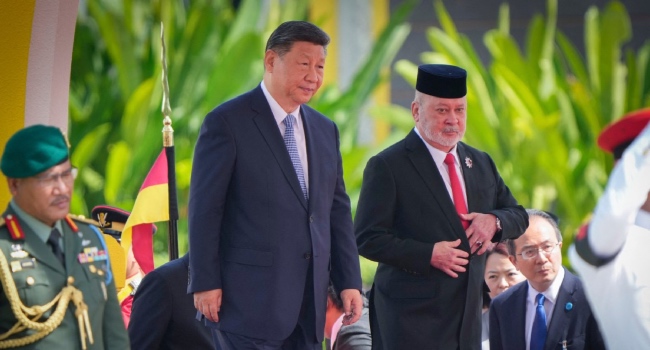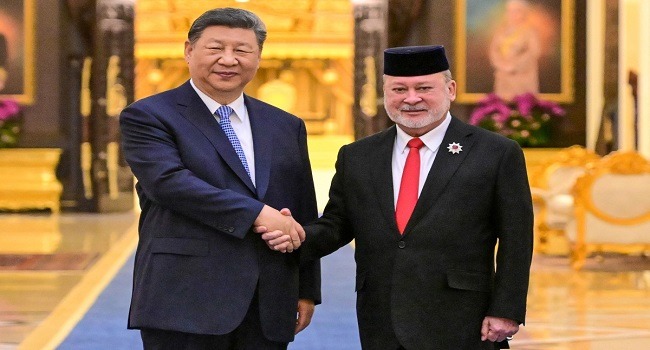Chinese President Xi Jinping met with Malaysian leaders on April 16, 2025, during a state visit aimed at reinforcing diplomatic and economic ties between the two nations. The visit, part of Xi’s broader Southeast Asia tour that includes Vietnam and Cambodia, underscores China’s efforts to position itself as a dependable partner in the region amid global trade disruptions caused by US President Donald Trump’s tariff policies.
A Warm Welcome and Strategic Discussions
Xi was greeted by Malaysia’s King Sultan Ibrahim at the National Palace in Kuala Lumpur with a vibrant ceremony, featuring a red-carpet walk, an honour guard inspection, and music from a royal band. Following a private audience and lunch with the king, Xi met Prime Minister Anwar Ibrahim in Putrajaya to discuss deepening bilateral cooperation. The leaders oversaw the signing of agreements in emerging technologies, artificial intelligence, media, film, and tourism, signaling a commitment to expanding collaboration across diverse sectors. Prime Minister Anwar hosted Xi for dinner at his official residence later that day.

Malaysian King Sultan Ibrahim (R) walks with Chinese President Xi Jinping during a welcoming ceremony at the National Palace in Kuala Lumpur on April 16, 2025. (Photo by Vincent Thian / POOL / AFP)
A Counterbalance to US Tariffs
The visit comes at a critical time for Southeast Asia, as the region grapples with the fallout from Trump’s punitive tariffs. Malaysia, the third-largest economy in Southeast Asia and this year’s ASEAN chair, was hit with a 24 percent tariff, while Vietnam and Cambodia faced steeper levies of 46 percent and 49 percent, respectively. Although these tariffs have been paused for 90 days, Trump has warned that no country is “off the hook,” creating uncertainty for the region.
Analysts see Xi’s tour as a strategic move to counterbalance US influence. Khoo Ying Hooi, an associate professor at Malaya University, described the visit as an effort to “realign the regional centre of gravity towards Beijing” and test ASEAN solidarity amid global market disruptions. She noted that Xi is likely framing China as a partner for stability and development, while subtly warning against letting US tariffs or alliances fracture regional cohesion. Oh Ei Sun from the Pacific Research Center of Malaysia likened the visit to “friends huddling together for warmth against harsh weather,” highlighting the shared challenges faced by ASEAN nations.
Deepening a Longstanding Partnership
China has been Malaysia’s largest trading partner for 16 consecutive years, with bilateral trade accounting for 16.8 percent of Malaysia’s global trade in 2024, according to the Malaysian foreign ministry. The two countries celebrated 50 years of diplomatic relations last year, though tensions persist over competing claims in the South China Sea, where Beijing asserts near-total sovereignty. Despite this, Xi expressed optimism about the future, stating on arrival that he hopes his visit will usher in another “50 golden years” of China-Malaysia relations. “I am confident that with our joint efforts, this will be a fruitful visit,” he said in a statement released by the Chinese Embassy in Kuala Lumpur.

his handout photo taken and released by Malaysia’s Department of Information on April 16, 2025 shows Malaysia’s King Sultan Ibrahim (Center R) and China’s President Xi Jinping (Center L) standing during their meeting at the National Palace in Kuala Lumpur. (Photo by FAMER ROHENI / MALAYSIA’S DEPARTMENT OF INFORMATION / AFP)
In an opinion piece published in Malaysia’s The Star newspaper, Xi emphasized China’s commitment to working with Southeast Asian nations to combat protectionism and maintain stable global supply chains. “We must uphold the multilateral trading system, keep global industrial and supply chains stable, and maintain an international environment of openness and cooperation,” he wrote, signaling Beijing’s intent to lead on regional economic stability.
Looking Ahead
Xi’s visit to Malaysia is part of a broader effort to strengthen China’s influence in Southeast Asia, a region increasingly caught between competing global powers. After Malaysia, Xi will travel to Cambodia, a key ally where China has significantly expanded its presence in recent years. As ASEAN navigates the challenges of US tariffs and global economic uncertainty, China’s outreach highlights its ambition to be seen as a stabilizing force—while subtly reinforcing its regional influence. For Malaysia, the visit reaffirms a partnership that remains vital to its economic growth, even as it balances complex geopolitical dynamics.






